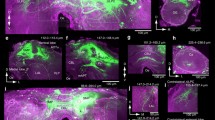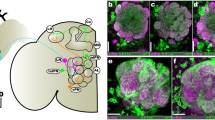Summary
-
1.
We have characterized the responses and structure of olfactory descending neurons (DNs) that reside in the protocerebrum (PC) of the brain of male sphinx moths Manduca sexta and project toward thoracic ganglia.
-
2.
Excitatory responses of DNs to pheromone blends were of two general types: (a) brief excitation (BE) that recovered to background in <1 s after the stimulus, and (b) long-lasting excitation (LLE) that outlasted the stimulus by ≥1 s and, in many cases, as long as 30 s. Individual pheromone components were ineffective in eliciting LLE.
-
3.
Some neurons showing LLE also exhibited state-dependent responses to pheromonal stimuli. When such neurons were in a state of low background firing, stimulation with pheromone blend elicited LLE. When they were in a state of LLE, an identical stimulus reduced firing for 5–10 s after which firing gradually increased to the initial higher level.
-
4.
Thirteen stained DNs were reconstructed from serial sections for detailed analysis of their morphology in the brain. DNs exhibiting LLE had neurites concentrated in the lateral accessory lobes (LALs) in the protocerebrum and adjacent neuropil. Most DNs exhibiting only BE to pheromonal stimuli and other DNs showing responses only to visual or mechanosensory stimuli did not have branches in the LALs.
Similar content being viewed by others
Abbreviations
- AL :
-
antennal lobe
- aL α :
-
lobe of the mushroom body
- AMMC :
-
antennal motor and mechanosensory center
- BE :
-
brief excitation
- bL β :
-
lobe of the mushroom body
- Ca :
-
primary calyces of the mushroom body
- CB :
-
central body
- DN :
-
descending neuron
- FE :
-
female equivalent
- IACT :
-
inner antenno-cerebral tract
- L :
-
lateral
- LAL :
-
lateral accessory lobe
- LLE :
-
long-lasting excitation
- MB :
-
mushroom body
- OACT :
-
uter antenno-cerebral tract
- Oe :
-
oesophageal foramen
- P :
-
pedunculus
- PC :
-
protocerebrum
- PCN :
-
protocerebral neuron
- SOG :
-
suboesophageal ganglion
- LY :
-
Lucifer Yellow CH
- TES :
-
N-trishydroxymethyl]methyl-2-aminoethanesulfonic acid
- VNC :
-
ventral nerve cord
- YL :
-
Y-lobe of the mushroom body
References
Arbas EA, Calabrese RL (1984) Rate modification in the heartbeat central pattern generator of the medicinal leech. J Comp Physiol A 155:783–794
Arbas EA, Kanzaki R, Hildebrand JG (1990) State-dependent activity changes in descending neurons in olfactory pathways of Manduca sexta. Soc Neurosci Abstr 16:758
Baker TC (1990) Upwind flight and casting flight: Complementary phasic and tonic systems used for location of sex pheromonesources by male moths. In: Døving KB (ed) Proc 10th Int Symp Olfaction and Taste, Oslo, pp 18–25
Boeckh J, Ernst K-D (1987) Contribution of single unit analysis in insects to an understanding of olfactory function. J Comp Physiol A 161:549–565
Brodfuehrer PD, Friesen WO (1986) Initiation of swimming activity by trigger neurons in the leech subesophageal ganglion I. Output connections of Tr1 and Tr2. J Comp Physiol A 159:489–502
Christensen TA, Hildebrand JG (1987) Male-specific, sex pheromone-selective projection neurons in the antennal lobes of the moth Manduca sexta. J Comp Physiol A 160:553–569
Derby CD, Blaustein DN (1988) Morphological and physiological characterization of individual olfactory interneurons connecting the brain and eyestalk ganglia of the crayfish. J Comp Physiol A 163:777–794
Dickinson PS, Nagy F (1983) Control of a central pattern generator by an identified modulatory interneurone in Crustacea II. Induction and modification of plateau properties in pyloric neurones. J Exp Biol 105:59–82
Hamilton KA, Ache BW (1983) Olfactory excitation of interneurons in the brain of the spiny lobster. J Comp Physiol 150:129–140
Hensler K (1989) Corrective flight steering in locusts: Convergence of extero- and proprioceptive inputs in descending deviation detectors. In: Singh RN, Strausfeld NJ (eds) Neurobiology of sensory systems. Plenum Press, New York, pp 531–544
Homberg U, Montague RA, Hildebrand JG (1988) Anatomy of antenno-cerebral pathway in the brain of the sphinx moth Manduca sexta. Cell Tissue Res 254:255–281
Homberg U, Christensen TA, Hildebrand JG (1989) Structure and function of the deutocerebrum in insects. Annu Rev Entomol 34:477–501
Kaissling K-E, Kramer E (1990) Sensory basis of pheromone-mediated orientation in moths. Verh Dtsch Zool Ges 83:109–131
Kaissling K-E, Hildebrand JG, Tumlinson JH (1989) Pheromone receptor cells in the male moth Manduca sexta. Arch Insect Biochem Physiol 10:273–279
Kanzaki R (1989) Physiology and morphology of higher-order neurons in olfactory pathways of the moth brain: Pheromone-processing neurons in the protocerebrum. In: Erber J, Menzel R, Pflüger HJ, Todt D (eds) Neural mechanisms of behavior. Proc 2nd Int Congress Neuroethology. G. Thieme, Stuttgart New York, pp 253–254
Kanzaki R, Arbas EA (1990) Olfactory and visual influences on fictive flight in Manduca sexta. Soc Neurosci Abstr 16:758
Kanzaki R, Shibuya T (1986) Descending protocerebral neurons related to the mating dance of the male silkworm moth. Brain Res 377:378–382
Kanzaki R, Arbas EA, Strausfeld NJ, Hildebrand JG (1989) Physiology and morphology of projection neurons in the antennal lobe of the male moth Manduca sexta. J Comp Physiol A 165:427–453
Kanzaki R, Arbas EA, Hildebrand JG (1991) Physiology and morphology of protocerebral olfactory neurons of the male moth Manduca sexta. J Comp Physiol A 168:281–298
Katz PS, Harris-Warrick RM (1989) Serotonergic/cholinergic muscle receptor cells in the crab stomatogastric nervous system. II. Rapid nicotinic and prolonged modulatory effects on neurons in the stomatogastric ganglion. J Neurophysiol 62:571–581
Kennedy JS (1983) Zigzagging and casting as a programmed response to wind-borne odour: a review. Physiol Entomol 8:109–120
Lehman HK (1990) Circadian control of Manduca sexta flight. Soc Neurosci Abstr 16:1334
Lennard PR, Getting PA, Hume RI (1980) Central pattern generator mediating swimming in Tritonia. II. Initiation, maintenance, and termination. J Neurophysiol 44:165–173
Matsumoto SG, Hildebrand JG (1981) Olfactory mechanisms in the moth Manduca sexta: Response characteristics and morphology of central neurons in the antennal lobes. Proc R Soc Lond B 213:249–277
Olberg RM (1983) Pheromone-triggered flip-flopping interneurons in the ventral nerve cord of the silkworm moth, Bombyx mori. J Comp Physiol A 152:297–307
Olberg RM, Willis MA (1990) Pheromone modulated optomotor response in male gypsy moths, Lymantria dispar L.: Directionally selective visual interneurons in the ventral nerve cord. J Comp Physiol A 167:707–714
Sanes JR, Hildebrand JG (1976) Origin and morphogenesis of sensory neurons in an insect antenna. Dev Biol 51:300–319
Schneiderman AM, Hildebrand JG, Brennan MM, Tumlinson JH (1986) Trans-sexually grafted antennae alter pheromone-directed behaviour in a moth. Nature 323:801–803
Schweitzer ES, Sanes JR, Hildebrand JG (1976) Ontogeny of electroantennogram responses in the moth, Manduca sexta. J Insect Physiol 22:955–960
Starratt AM, Dahm KH, Allen N, Hildebrand JG, Payne TL, Roller H (1978) Bombykal, a sex pheromone of the sphinx moth, Manduca sexta. Z Naturforsch 34C:9–12
Tolbert LP, Matsumoto SG, Hildebrand JG (1983) Development of synapses in the antennal lobes of the moth Manduca sexta during metamorphosis. J Neurosci 3:1158–1175
Tumlinson JH, Brennan MM, Doolittle RE, Mitchell ER, Brabham A, Mazomenos BE, Baumhover AH, Jackson DM (1989) Identification of a pheromone blend attractive to Manduca sexta (L.) males in a wind tunnel. Arch Insect Biochem Physiol 10:255–271
Weeks JC, Kristan WB Jr (1978) Initiation, maintenance and modulation of swimming in the medicinal leech by the activity of a single neurone. J Exp Biol 77:71–88
Wiersma CAG, Yanagisawa K (1971) On types of interneurons responding to visual stimulation present in the optic nerve of the rock lobster, Panulirus interruptus. J Neurobiol 2:291–309
Wiersma CAG, York B (1972) Properties of the seeing fibers in the rock lobster: Field structure, habituation, attention and distraction. Vision Res 12:627–640
Williamson R, Burns MD (1982) Large neurones in locust neck connectives. J Comp Physiol 147:379–388
Willis MA, Arbas EA (1990) Odor-mediated upwind flight behavior of the tobacco hornworm moth Manduca sexta. Soc Neurosci Abstr 16:757
Willis MA, Arbas EA (1991) Odor-modulated upwind flight behavior of the tobacco hornworm moth Manduca sexta. J Comp Physiol A, In press
Willows AOD, Lloyd PE, Masinovsy BP (1988) Multiple transmitter neurons in Tritonia III. Modulation of central pattern generator controlling feeding. J Neurobiol 19:69–86
Author information
Authors and Affiliations
Rights and permissions
About this article
Cite this article
Kanzaki, R., Arbas, E.A. & Hildebrand, J.G. Physiology and morphology of descending neurons in pheromone-processing olfactory pathways in the male moth Manduca sexta . J Comp Physiol A 169, 1–14 (1991). https://doi.org/10.1007/BF00198168
Accepted:
Issue Date:
DOI: https://doi.org/10.1007/BF00198168




